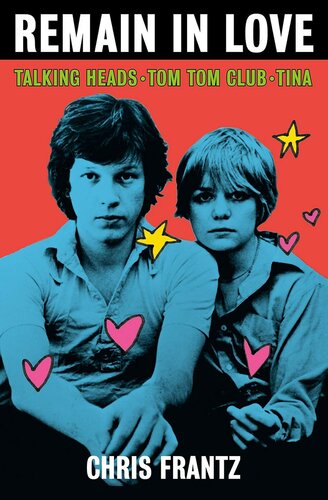
Remain in Love
Talking Heads, Tom Tom Club, Tina
کتاب های مرتبط
- اطلاعات
- نقد و بررسی
- دیدگاه کاربران
نقد و بررسی

March 1, 2020
A music memoir that is as much about love as music. Frantz's highly detailed, "true inside story" begins with a pleasant boyhood. Born to a military family, he moved around, went to good schools, enjoyed listening to music--especially the Beatles--played drums, and joined various bands. While attending Rhode Island School of Design, he met fellow art students Tina Weymouth, his future wife, and the aloof David Byrne, who, Frantz writes, "got into music to get out of himself." Weymouth and Frantz helped Byrne write lyrics for "Psycho Killer," and Frantz wrote "Warning Sign," which Byrne later took sole credit for. Throughout, the author offers a devastating portrait of Byrne as a back-stabbing liar who aggrandized himself while disrespecting his band mates. Their first band, the Artistics, played some venues, and they moved to New York's Bowery in 1974, where they got a regular gig playing as Talking Heads at the CBGB club, their all-time favorite venue. A keyboard player, Jerry Harrison, formerly of Modern Lovers, joined them. The star-struck Frantz began meeting people like Patti Smith, John Cale, Debbie Harry, Lou Reed, and Andy Warhol. Throughout the narrative, he proves to be an inveterate name-dropper. Frantz describes the band as "pioneers" in the "Punk/New Wave/Post-Punk music" scene. In 1976, they played 76 gigs. At this time, Byrne wanted to kick Weymouth out of the band, but as the author rightly notes, her inventiveness on bass "was one reason Talking Heads sounded so unique." In 1977, they recorded their first album and toured Europe with the Ramones. Afterward, Frantz and Weymouth got married. Though not the most elegant stylist, the author offers entertaining stories about Stop Making Sense, Jonathan Demme's documentary about the band; the origins of the Tom Tom Club; Byrne's big white suit; and the day, in 1991, Byrne "sneaked out of Talking Heads." Although written in mostly colorless prose, this is a gold mine for fans of the 1970s and '80s music scene.
COPYRIGHT(2020) Kirkus Reviews, ALL RIGHTS RESERVED.

April 1, 2020
Mixing punk, new wave, pop, dance, and world music, Talking Heads were one of rock's great innovative bands as well as commercial and critical genre favorites in the later 1970s and 1980s. Here, drummer and cofounder Frantz recounts his own life and the band's story in a rich, entertaining memoir. Frantz met his future bandmates David Byrne and Tina Weymouth (whom he married) at art school in Rhode Island, and, along with Jerry Harrison, Talking Heads performed early gigs in New York, eventually recording albums and touring Europe with the Ramones. With an eye for detail, Frantz presents sharply drawn pictures of the nascent punk and postpunk world of New York City, life on the road, and, later, the work he and Weymouth did in their group Tom Tom Club. He blends thumbnail portraits of notables he met with tidbits about daily life that charmingly meander from food to travel. VERDICT Frantz's absorbing, vivid book will reward Talking Heads fans and those interested in the postpunk and 1980s music scene. [See Prepub Alert, 11/11/19.]--James Collins, Morristown-Morris Twp. P.L., NJ
Copyright 2020 Library Journal, LLC Used with permission.

April 13, 2020
Talking Heads drummer Frantz delivers a bright memoir that reads more of an entertaining greatest-hits compilation than complete life chronicle. He discusses his early musical influences (R&B, Fela Kuti, and Kraftwerk) and how the band first came together in 1973 at the Rhode Island School of Design as a herky-jerky art-rock trio called the Artistics, with singer-songwriter David Byrne and bassist Tina Weymouth (whom Frantz later married). The band moved to Manhattan the next year and its burgeoning punk music scene, where, Frantz notes, the Talking Heads “were not afraid to appear straight.” His account of their 1977 Europe tour with the Ramones, studded with set lists and bright detail, is particularly thrilling (“we were post-punk before there even was punk”). In 1991, the band broke up when Byrne left. (Frantz writes of Byrne’s self-aggrandizement and suggests he is on the spectrum.) Later sections on Frantz and Tina’s epochal dance-band, Tom Tom Club, and their time recording and producing in the Bahamas, are replete with fun cameos (the Clash, Robert Palmer, Grace Jones). Fun, cheerful, and eventful, this memoir has just the right amount edge.

























دیدگاه کاربران